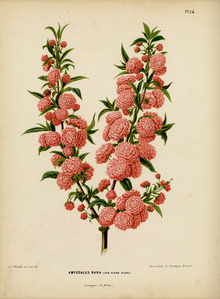pt-BR
nomes no trilho de navegação


Prunus japonica (also Cerasus japonica), also called Japanese bush cherry,[1] Flowering almond or Oriental bush cherry, is a shrub species in the genus Prunus, that is widely cultivated for ornamental use. Its native range extends from Central China through to the Korean peninsula. P. maximowiczii, the Miyama cherry is also often referred to as Japanese bush cherry.
Prunus japonica (lat. Prunus japonica) - gülçiçəyikimilər fəsiləsinin gavalı cinsinə aid bitki növü.
Prunus japonica (lat. Prunus japonica) - gülçiçəyikimilər fəsiləsinin gavalı cinsinə aid bitki növü.
Prunus japonica (també dit Cerasus japonica) o cirerer arbustiu japonès[1] és una espècie d'arbiust del gènere Prunus, molt cultivada com planta ornamental. Està distribuït des de la Xina central a Corea. P. maximowiczii, o cirerer Miyama, sovint també s'anomena cirerer arbustiu japonès.
Floreix al maig. Els seus fruits fan 14 mm i tenen un flaire dolç agradable. Se'n fan pastissos però el seu sabor és bastant agre.
Es creu que els fruits contenen amigdalina i prunasina, com altres espècies del mateix gènere. Làcid hidrociànic que formen és verinós però en petites dosis poden estimular la respiració i millorar la digestió.
El pinyol de Prunus japonica és desobstructor, aperitiu, demulcent, carminatiu, diurètic, laxant, hipotensor, oftàlmic i lenitiu.
Prunus japonica (també dit Cerasus japonica) o cirerer arbustiu japonès és una espècie d'arbiust del gènere Prunus, molt cultivada com planta ornamental. Està distribuït des de la Xina central a Corea. P. maximowiczii, o cirerer Miyama, sovint també s'anomena cirerer arbustiu japonès.
Floreix al maig. Els seus fruits fan 14 mm i tenen un flaire dolç agradable. Se'n fan pastissos però el seu sabor és bastant agre.
Ang almendro (Ingles: Korean cherry, flowering almond, oriental bush cherry; pangalang siyentipiko: Prunus japonica o Cerasus japonica), ay isang uri ng palumpong na nasa saring Prunus. Sa pangkalahatan, inaalagaan at pinararami lamang ang mga ito para magsilbing mga halamang pandekorasyon.
![]() Ang lathalaing ito ay isang usbong. Makatutulong ka sa Wikipedia sa nito.
Ang lathalaing ito ay isang usbong. Makatutulong ka sa Wikipedia sa nito.

Prunus japonica (also Cerasus japonica), also called Japanese bush cherry,[1] Oriental bush cherry, or Korean bush cherry is a shrub species in the genus Prunus that is widely cultivated for ornamental use. Its native range extends from Central China through to the Korean peninsula.
The shrub reaches 1.5 m by 1.5 m. Its flowers are hermaphrodite and are pollinated by insects. The plant blossoms in May.[1] Its fruit reaches about 14 mm and has an agreeably sweet flavor, therefore it is used in making pies, but its taste is quite sour, reminiscent of that of sour cherry.
Each fruit has one seed. The plant usually grows from seed but can also be propagated through cutting or layering.
The plant thrives on well-drained and moist loamy soil and prefers little shade or no shade at all. The plant prefers some lime in the soil but not too much. It is mostly found at woodlands or sunny places.[2]
The leaves of this plant procure a green dye, while the fruit procures a greenish to grayish dye.
There are several varieties:
 A blossom
A blossom  Prunus japonica by A.J. Wendel, 1868
Prunus japonica by A.J. Wendel, 1868 Prunus japonica (also Cerasus japonica), also called Japanese bush cherry, Oriental bush cherry, or Korean bush cherry is a shrub species in the genus Prunus that is widely cultivated for ornamental use. Its native range extends from Central China through to the Korean peninsula.
Prunus japonica Thunb., 1784, comunemente noto come ciliegio coreano, è un cespuglio della famiglia delle Rosacee[1], estesamente coltivato per usi ornamentali, ma in diverse varietà appositamente selezionate, anche come frutta di un certo rilievo.
La regione di origine si estende dalla Cina centrale fino a tutta la penisola della Corea; anche il P. maximowiczii, detto anche "Miyama cherry" è spesso richiamato come 'ciliegio coreano'.
Il cespuglio raggiunge raramente altezze superiori a 1,5 m, con larghezza dello stesso ordine di misura. I frutti hanno un diametro di circa 14–15 mm, sono di un gradevole sapore dolce con un fondo acidulo-amaro, che ricorda quello delle amarene. I frutti possono essere coltivati freschi o trasformati in composte.
la pianta, se non si richiedono particolari conservazioni delle caratteristiche della pianta madre, possono facilmente essere riprodotte da seme; altrimenti possono essere moltiplicate per via vegetativa (talea o propaggine).
La pianta preferisce suoli drenati, non ha esigenza di suoli particolarmente ricchi. È pianta da ambiente ben soleggiato, ma tollera lievi ombreggiature.
La pianta, con i suoi componenti in amigdalina ed analoghi, (precursori del'acido cianidrico), è estesamente usata, in dosi adeguate, (l'acido cianidrico è tossico ad alte dosi), dalla medicina tradizionale cinese come stimolante della respirazione e per migliorare la digestione, oltre a numerose altre attività attribuite: come ipotensivo, antiedemico, narcotico, ecc..
Le foglie sono usate per ottenere una tintura per i tessuti di colore verde, i frutti invece danno una tintura verdastro-grigia.
Sono descritte diverse varietà:
Prunus japonica Thunb., 1784, comunemente noto come ciliegio coreano, è un cespuglio della famiglia delle Rosacee, estesamente coltivato per usi ornamentali, ma in diverse varietà appositamente selezionate, anche come frutta di un certo rilievo.
La regione di origine si estende dalla Cina centrale fino a tutta la penisola della Corea; anche il P. maximowiczii, detto anche "Miyama cherry" è spesso richiamato come 'ciliegio coreano'.
Úc lý, còn gọi là uất lý (tên khoa học: Prunus japonica), là loài thực vật có hoa trong họ Hoa hồng. Loài này được (Thunb.) Loisel. mô tả khoa học đầu tiên năm 1812.[1]
Úc lý, còn gọi là uất lý (tên khoa học: Prunus japonica), là loài thực vật có hoa trong họ Hoa hồng. Loài này được (Thunb.) Loisel. mô tả khoa học đầu tiên năm 1812.
郁李(学名:Prunus japonica)又稱栘、唐棣、常棣、棠棣、薁李。是一种蔷薇科落叶小灌木。春天的时候开花,花的颜色有粉红色的,也有白色的。果实是暗红色的,可以吃。种子就叫做“郁李仁”,可以做中药;研碎來煮粥可通便。



ニワウメ(庭梅,Prunus japonica、またはCerasus japonica)はバラ科の低木種。英語ではJapanese bush cherry[2]、またはOriental bush cherryなどと呼ばれる。中国語では郁李。
中国華北、華中、華南などの山地に自生し、日本へは江戸時代に渡来した[3]。観賞用のために広く栽培されている。
Japanese bush cherryはミヤマザクラをさすこともある。
大きさは1.5×1.5mほどの大きさになる。花は雌雄同体で虫媒花である。花は5月に咲く。
実は甘い香りがし、14mmほどの大きさになり、パイやジャムなどに利用されることもあるが味はスミミザクラと似て酸味が強い。
各果実には種が一つ入っている。種から増やすことが一般的であるが、取り木でも増やせる。
森林地帯や日当たりの良い場所で発見された植物で、水はけは良いが湿り気のあるローム状の土を好み、ややかげる程度か日向を好む。土壌中にいくらか石灰が入っているほうが良いが、多くなくて良い。
科学的に確立されたものではないが、この種は他のサクラ属の種と同様アミグダリン、プルナシンを含むと考えられている[誰によって?]。これらの化合物は腸内細菌が持つβ-グルコシダーゼといった酵素で加水分解された場合、有毒のシアン化水素を形成する[要出典]。
ニワウメの仁は汎用性が高く下剤、利尿剤、血圧降下などに使われ、便秘、浮腫、不眠症に内服として処方される[4]。
仁以外もまれに利用される。たとえば根は便秘、子供の熱、歯の問題などに利用される
葉は緑の染料となり、実は灰色がかった緑の染料になる。
以下のようにいくつかの品種および変種が存在する[5]:
ニワウメ(庭梅,Prunus japonica、またはCerasus japonica)はバラ科の低木種。英語ではJapanese bush cherry、またはOriental bush cherryなどと呼ばれる。中国語では郁李。
中国華北、華中、華南などの山地に自生し、日本へは江戸時代に渡来した。観賞用のために広く栽培されている。
Japanese bush cherryはミヤマザクラをさすこともある。